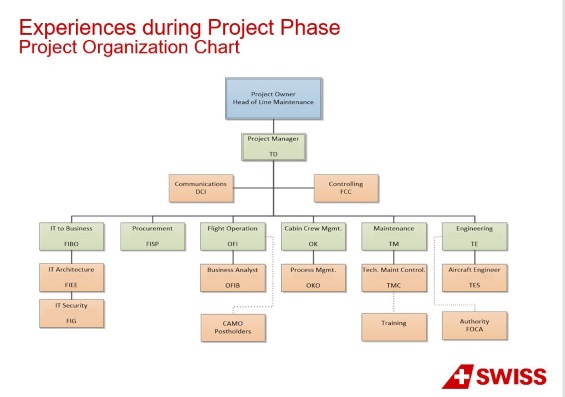Articles
| Name | Author | |
|---|---|---|
| Case Study: Using technology to improve flight ops experiences at IndiGo | Aakash Bhatnagar, Director-Flight Operations Support, IndiGo, and William Hu, Regional Head/Senior Sales Director, Asia Pacific Region, NAVBLUE | View article |
| Case Study: SWISS International Air Lines introduces an Electronic Log Book (eTL/ELB) | Marcus Di Laurenzio, Project Manager, SWISS International Air Lines, and Udo Stapf, CEO, CrossConsense | View article |
| ATM Enhancements and Trajectory Based Operation (TBO) from ICAO | Henk Hof, Head of ICAO & Concepts Unit, Eurocontrol | View article |
| Case Study: Icelandair EFB Project | Captain Grétar Mar Óðinsson, Lead EFB Project Team Manager & Capt B757, Icelandair, and Jens Pisarski, COO & Partner at International Flight Support | View article |
Case Study: SWISS International Air Lines introduces an Electronic Log Book (eTL/ELB)
Author: Marcus Di Laurenzio, Project Manager, SWISS International Air Lines, and Udo Stapf, CEO, CrossConsense
Subscribe
SWISS International Air Lines the paperless experience
Udo Stapf, CEO of CrossConsense and Marcus Di Laurenzio, Project Manager at SWISS International Air Lines share SWISS’s experience adopting an electronic Technical Logbook/Electronic Log Book (eTL/ELB)
ABOUT SWISS INTERNATIONAL AIR LINES (SWISS)
SWISS carries some 16 million passengers a year in a fleet of 94 state-of-the-art aircraft including 30 long-haul and 52 short-haul. The airline is a member of the Star Alliance and has been part of the Lufthansa Group since 2005. From a total workforce of over 8,500, nearly 1,400 are cockpit crew, more than 3,800 are cabin crew and nearly 3,400 are ground staff.
ABOUT THE PROJECT
When the electronic Technical Logbook/Electronic Log Book (eTL/ELB) project was started, SWISS first considered what kind of areas would be affected by the implementation, from which a large organization chart was developed (figure 1).

Figure 1
What the chart makes clear is that this type of software has an impact in every part of the airline. A large project team is needed because it’s not only a maintenance project but it’s also a flight ops project and it’s always a challenge to align the different interests of pilots, line engineers and base engineers.
The current set-up at SWISS International Air Lines is to install the technical logbook used by the pilot and, because it’s a legal requirement, to have a secondary device on board in the hands of the cabin crew so that they can also collect and record cabin defects from their part of the aircraft. So, should the pilot’s device fail for any reason or run out of charge, the SD Card can be removed from the pilot’s device and put into the cabin device to allow the pilot to work with that as a spare device.
The device currently in use at SWISS is the Surface Pro 3 tablet. Because they are not yet using Inmarsat or SITAONAIR for permanent connectivity, there is a small router on board, which establishes a 3G or a Wi-Fi connection as well as a hotspot for the cabin and pilot devices to communicate with each other.
The current status on the SWISS fleet is that roll out of the eTL/ELB started on their new Boeing 777s, which are all equipped before delivery with the electronic techlog, and then installation has continued with the rest of the long-haul fleet (Airbus A330s and A340s) because it’s easier getting used to the electronic techlog on the long-haul fleet. The new Bombardier C-Series were already equipped with the electronic techlog and roll-out was completed at the time of writing on the Airbus A320, A321 and A319 family as well as on the Avro Regional Jets in the fleet.
BUSINESS CASE STUDY: PAPER LOGBOOK vs ELB
The reason the project commenced was to determine what could be achieved with an electronic techlog. The airline was receiving about 70,000 reports a year – cabin complaints, pilot complaints, maintenance defects – which were all handled manually because it was a paper process. There was a central booking staff where the copies of the paper logbooks were handed to central data typists to enter the data to the system and SWISS wanted to eliminate this function along with eliminating typing errors – it wasn’t the errors alone that caused them a big problem, sometimes it was also the time needed to correct the error. In some cases, the problem entry might have to be returned to the pilot who might be on his three weeks off duty at the time. There are no typos anymore because everything that a pilot enters into the system goes straight to the backend without further transcription. This really increased the efficiency in reporting.
The project started in 2014 and Swiss expects to have a return on investment (ROI) by the middle of 2017, just from the money saved.

Figure 2
The graph in figure 2 shows the progress and financial impact of the project. It will not continue in this way indefinitely, the airline won’t be much richer than before and the cumulative impact curve will level out at some future point but the eTL/ELB has turned out to be a cost saving solution as well.
SWISS chose CROSSMOS, a brand new product from CrossConsense, a software developer that has previously specialized in support for AMOS from Swiss Aviation Software (Swiss-AS), data transfer and app development. So CrossConsense worked with SWISS and ten other airlines to develop the standard eTL/ELB product CROSSMOS which is now established.
Fortunately, because CrossConsense had already undertaken AMOS support for SWISS International Air Lines, they already knew about the organization and its processes; so it was an acceptable offer. Also, CrossConsense has been a long-standing partner with Swiss-AS who are the developers of AMOS.
EXPERIENCES DURING PROJECT PHASE
During the first seven months using the eTL/ELB from January to August 2016, there were about 13,000 complaints recorded (figure 3) which were directly transferred into AMOS; there was no problem at all using the interface with the back-end MRO system.

Figure 3
Notwithstanding that, there were problems with the devices which sometimes did not work and one of the biggest problems occurred when a battery ran out of charge. Because there were no charging facilities on the aircraft, the devices were charged overnight and distributed to the aircraft every morning. Crews were asked to switch off the devices when they were not in use and, in most cases where the battery ran out of charge, the crew had simply forgotten to switch it off. To correct this, SWISS, in addition to the instruction to switch off when not in use, installed an automatic sleep mode on the devices that activates after a period of non-use; plus there are now power outlets on board of the aircraft for the devices to use so that the devices are now always available and charged.
Another challenge was the network; there was often no available network but for several reasons. In some of the outstations where one would have expected great connectivity, there were places where none was available, including in New York at one position on the ramp where the user had to leave the aircraft and walk to the right wingtip in order to achieve connectivity with the Wi-Fi and to 3G. On the other hand, in stations such as Nairobi, connectivity worked with no problems at all. Another problem, in Bangkok, was that the provider had a very narrow bandwidth although that has now been improved.
CrossConsense, as part of the program, investigated the quality of connectivity and how good the transmission was into the back-end system. The investigation looked at more than 5,000 flights of which some 97 percent (a really good result) were synchronized successfully, without a problem. 157 flights used the back-up process in which they downloaded the data to be left on ground with the ground agent. And only 12 flights, of these more than 5,000, needed to resort to back up with paper. The average time per sync was 20 seconds which is good for 3G. Of course, synchronization sometimes failed at the first try because the router was not switched on, something that was easy to fix. So, about 3 percent did really fail – a good result. There were two cases where there was no connectivity at all to the ground server and from the ground server to the back-end. In one case Swisscom made changes to their mobile network but didn’t inform anybody resulting in two days with no connectivity at all including for all other airlines and users of Swisscom. In another case there was a problem with the VPN (virtual private network) connection following a change in their data center which resulted in about ten hours with no connectivity. Neither case was a problem because the CROSSMOS eTL/ELB solution is built to fly for about two weeks without connectivity; the latest status is always onboard and it can work with the offline procedure to synchronize data.
There were also problems with connectivity between the devices onboard sometimes. One cause was a known problem with Windows on Surface 3 when it comes to Wi-Fi connectivity, a problem on which Microsoft is working. In most cases a simple ‘turn it off and then turn it back on’ fixed it.
IMPROVEMENTS SINCE ROLLOUT
As is often the case, using the solution in practice has led to several improvements following rollout. There had been a problem with synchronizing the data because some PDF files were distributed too frequently. SWISS changed the data generation process for dent & buckle charts, which reduced the synchronization time dramatically and now it’s working without any problem. Some pilots would get nervous if they have to take off while the synchronization is still underway.
CHANGE MANAGEMENT
And then, of course, there were psychological problems with end users because most of them were used to the paper process which worked without problems. For this, SWISS undertook some internal training, showing people how to work with the tablet and how to work with touch screen applications. Now, the comments that paper is better are fast reducing in number as people become used to the new system.
As in any software process, not everybody is interested or positive but it’s really important to get them onboard as soon as possible, to ask them for improvements and to train super users. That really worked out well; people are very happy to work with the system.
MAINTENANCE EXPERIENCES
Software-Images were created for device roll-out, using a Windows 8 OS (operating system). The images lock down security aspects and make the rollout really simple, enabling SWISS to exchange devices quickly.
ARCHITECTURE AND DATA SECURITY
Figure 4 shows the current architecture for the eTL/ELB as well as data security, Wi-Fi, GSM and VPN connectivity.

Figure 4
There are the two devices onboard the aircraft in the cockpit and the cabin which communicate via Wi-Fi and transmit data via a Swisscom private network into the SWISS network from where it is sent to the CrossConsense ground server, a solution hosted by CrossConsense (Software as a Service – SaaS) and which, in turn, communicates with the AMOS server, the back-end MRO system. Once synchronization has been completed official work order numbers from AMOS will appear in the electronic techlog to confirm that the ground systems now know exactly what is going on and has registered the notes and defects. Thus the issue or defect will have been conformed to the user as received for action.
Contributor’s Details
 Udo Stapf, Chief Executive Officer, CrossConsense
Udo Stapf, Chief Executive Officer, CrossConsenseUdo Stapf is the founder and CEO of CrossConsense, an eLB, server hosting, software support- and solutions provider based in Frankfurt, Germany. Since 1990 he has been working in the aviation industry, starting as an aircraft line and base maintenance engineer and AMOS integration specialist. After he completed his degree as a business economist he worked as a logistics manager for a German charter airline until he founded CrossConsense 2002.
 Marcus Di Laurenzio, Project Manager at SWISS International Air Lines
Marcus Di Laurenzio, Project Manager at SWISS International Air LinesMarcus Di Laurenzio is the project manager of the SWISS Electronic Log Book project and coordinates all the stakeholders from operational- and technical business units. Marcus started his career as an aircraft Engineer 1988 with SWISSAIR technical department. After having completed his degree as an electronic specialist he worked in several engineering departments and operations (Dragon Air and Gulf Air). For the last two years, Marcus has been working for the projects implementation of an electronic log book of all aircraft types flying in the Swiss fleet and has setup infrastructure for enabling functions of the Boeing B777 model and as well for the Bombardier CS100/300 models.
 CrossConsense
CrossConsenseCrossConsense has become a recognized name in the aviation industry especially in the fields of AMOS consulting, support, hosting and operation. In 2012 CrossConsense started to develop – in collaboration with 11 airline customers –CROSSMOS, an electronic technical logbook (eTL). CROSSMOS has been developed with state-of-the-art methods and technologies to become the standard electronic techlog solution and is able to work with AMOS as well as other back-end MRO systems.
 Swiss International Air Lines
Swiss International Air LinesSwiss International Air Lines (SWISS) is the national airline of Switzerland. From Zurich and Geneva the SWISS fleet serves a total of 102 destinations worldwide in 46 countries. With a fleet of 93 aircraft SWISS transports over 16 million passengers annually. The cargo division SWISS WorldCargo offers a comprehensive airport-to-airport service for high-quality goods and care-intensive freight to 130 destinations in over 80 countries. As Switzerland’s national airline, SWISS stands for traditional values and is committed to the highest product- and service quality.
Comments (0)
There are currently no comments about this article.

To post a comment, please login or subscribe.